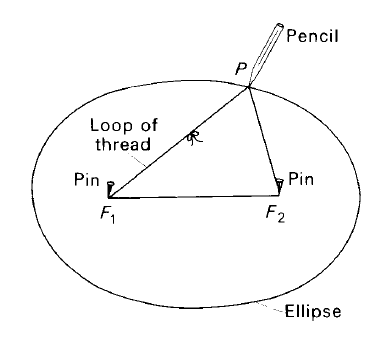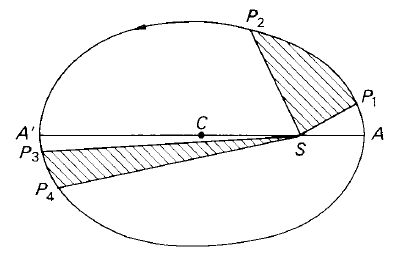
Kepler’s first law
 المؤلف:
A. Roy, D. Clarke
المؤلف:
A. Roy, D. Clarke
 المصدر:
Astronomy - Principles and Practice 4th ed
المصدر:
Astronomy - Principles and Practice 4th ed
 الجزء والصفحة:
p 167
الجزء والصفحة:
p 167
 9-8-2020
9-8-2020
 1974
1974
Kepler’s first law
The law states that the orbit of a planet is an ellipse with the Sun at one focus. A well-known way of drawing an ellipse is to insert two pins some distance apart at F1 and F2 in a sheet of paper (see figure 1), place a loop of thread over them, hold it taut by means of a pencil and then run the pencil along the path allowed by the tight loop. The figure obtained is an ellipse. The two positions occupied by the pins are called the foci.

Figure 1. Method of drawing an ellipse.
If the two pins are placed nearer to each other and the operation is repeated with the same loop, it is found that the ellipse is more circular than the previous one. The ellipse, in fact, becomes a circle in the limiting case where the two pins occupy the same position, i.e. only one pin is used. Figure 1 shows an elliptical planetary orbit, with the Sun, S, at one of the foci, as Kepler’s first

Figure 2. An elliptical planetary orbit.
law states. The other focus, F, is often called the empty focus. Then the line AA' is the major axis of the ellipse, C is the centre and, therefore, CA and CA' are the semi-major axes. Likewise BB' is the minor axis, with CB and CB' the semi minor axes. If a and b denote the lengths of the semi-major and semi-minor axes respectively, then
b2 = a2(1 − e2)

Figure 3. An orbital ellipse, illustrating Kepler’s second law.
where e is the eccentricity of the ellipse, a quantity defined by the relation
e = CS/CA.
The eccentricity gives an idea of how elongated the ellipse is. If the ellipse is a circle, e = 0, since S and F are coincident with C. The other limit for e is unity, obtained when the ellipse is so narrow and elongated that the empty focus is removed to infinity.
In fact, the planetary orbits are almost circular so that e is a small fraction.
Let P be the position of the planet in its orbit. Then SP is the planet’s radius vector. The planet is said to be at perihelion when it is at A. It is then nearest the Sun, since
SA = CA − CS = a − ae = a(1 − e).
When the planet is at A� it is said to be at aphelion, for it is then farthest from the Sun. We have,
then,
SA' = CA' + CS = a + ae = a(1 + e).
The angle ASP is called the true anomaly of the planet.
 الاكثر قراءة في مواضيع عامة في علم الفلك
الاكثر قراءة في مواضيع عامة في علم الفلك
 اخر الاخبار
اخر الاخبار
اخبار العتبة العباسية المقدسة


